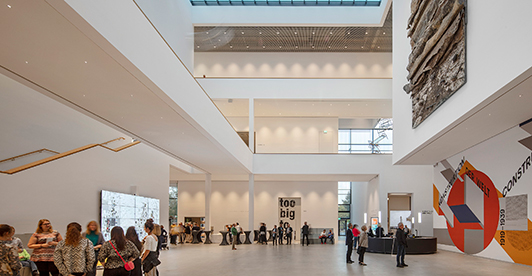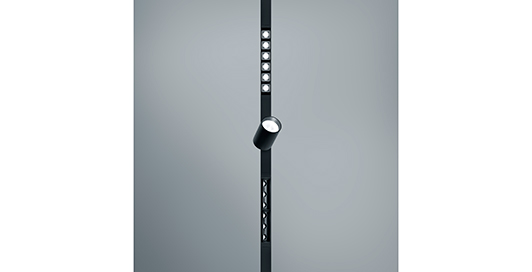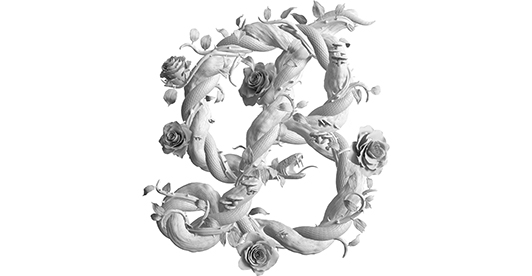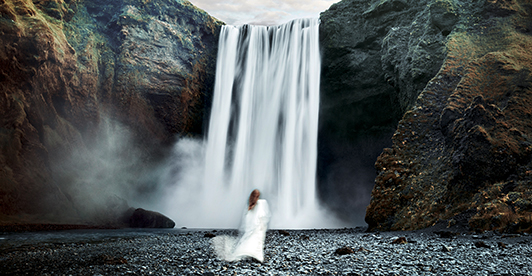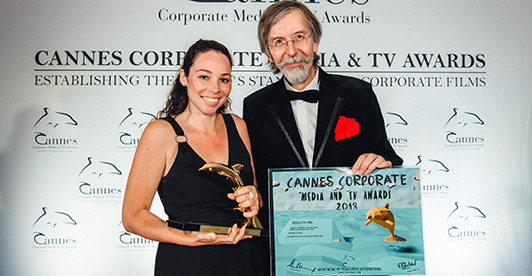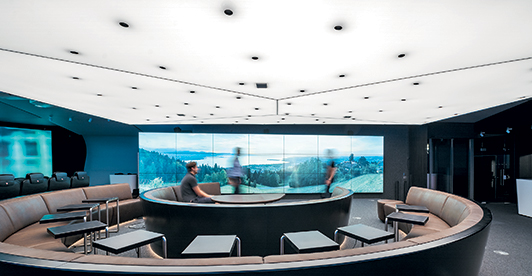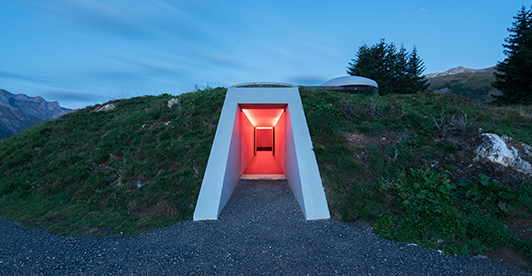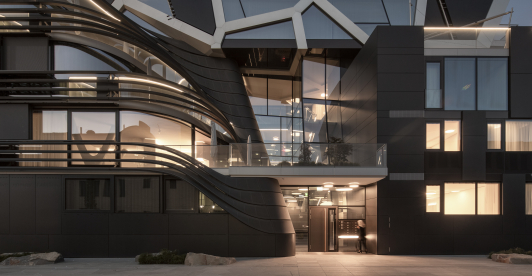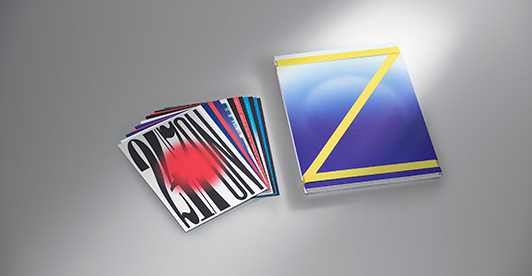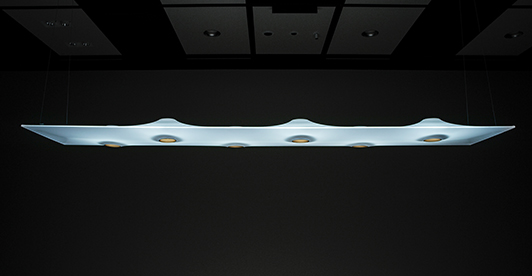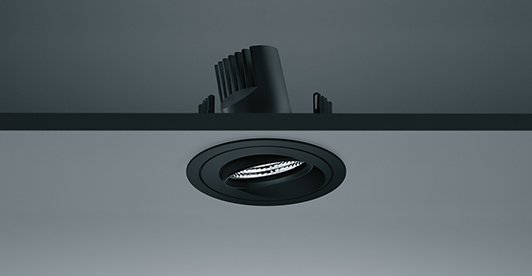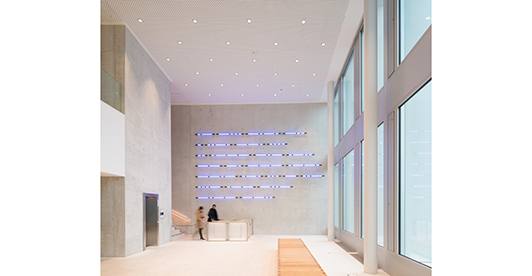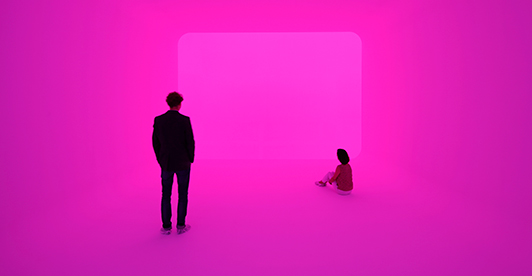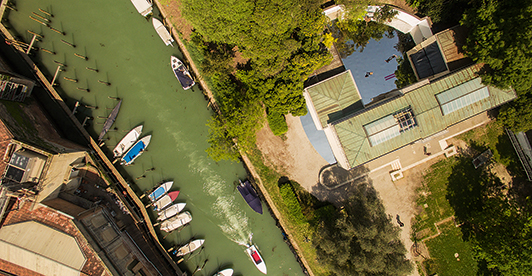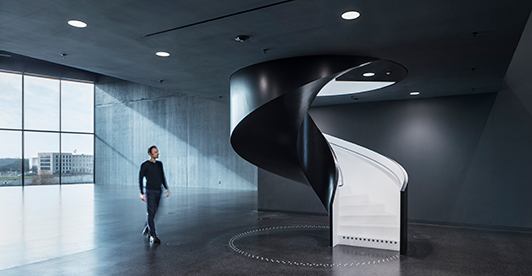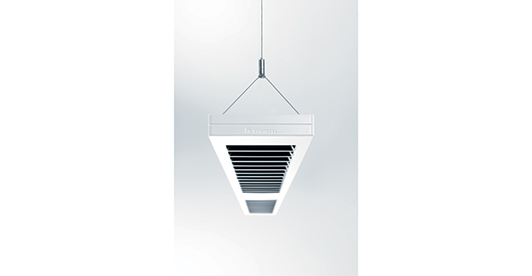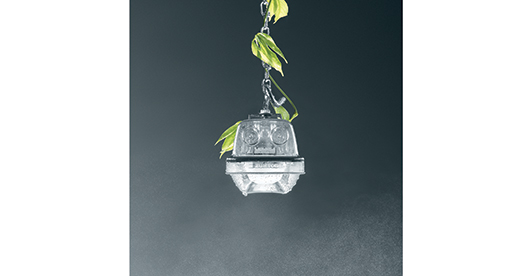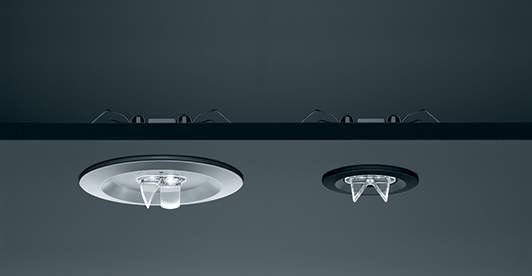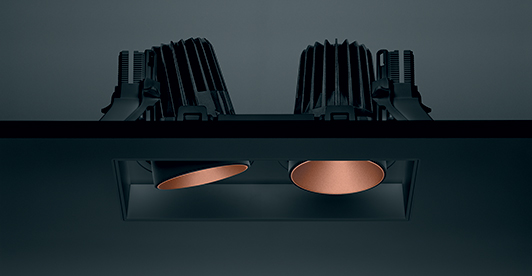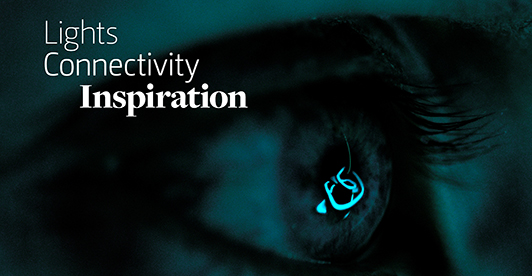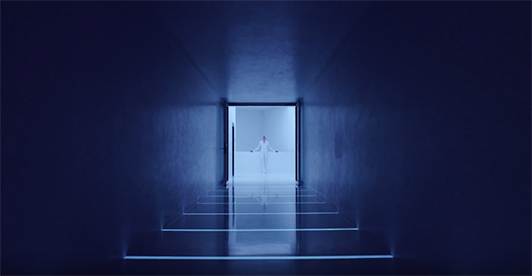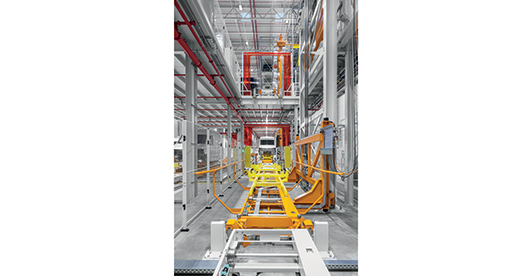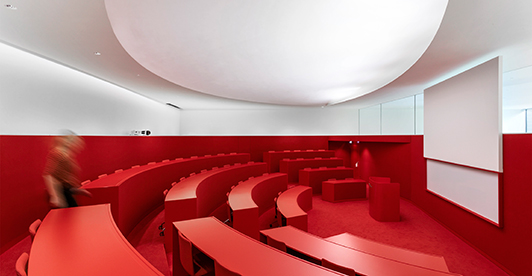Press Contact
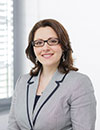
Head of Brand Marketing Zumtobel
Tel.: +49 170 3385 222
[email protected]
Press information 2018
-
11/2018Lighting Solution
A creative powerhouse for the arts – Zumtobel lights up a new building at the Kunsthalle Mannheim
Showcasing art with light is a Zumtobel specialty. Planning and realising a high-quality and perfectly tailored lighting solution not only helps preserve works of art, but also supports both the overall concept of the exhibition and the architecture of the museum. And that is exactly what has been achieved in close cooperation with a·g Licht at the Kunsthalle Mannheim – the largest new building at a German art museum in recent years. As a cultural temple to the urban future of Mannheim, architects from the Gerkan, Marg and Partner (gmp) architectural office have crafted a design that creates an elegant “city in the city”.More informationLess informationAs an essential part of the curatorial concept, light fundamentally shapes the emotional perception of architecture and art, helping observers to make a real sensory connection with the pieces on show. The seemingly simple-looking new building at the Kunsthalle Mannheim, which was recently opened to much fanfare after three years of construction, houses a radical museum concept – a concept in which the emotions behind the art play a role. A key role. The 68.3-million-euro building is currently the largest new construction at an art museum in the whole of Germany and has attracted almost 90,000 visitors in the first three months. Yet it is more than just the exceptional idea of the museum that draws people here. The unique architecture has also caught the eye. The Kunsthalle Mannheim is in fact a “city in the city”, where ten cubes invite visitors to really engage with the most varied aspects of art.
The scale of the rooms and especially the atrium, a 22-metre-high space awash with daylight, placed special demands on the lighting concept – which is why a clever solution devised by lighting design agency a·g Licht was required to place the 13,000 square metres of floor space in just the right light. Various factors helped Daniel Walden from a·g Licht make the call to involve Zumtobel with this lighting concept (and not just the long-standing cooperation between the two companies). “Zumtobel impressed with a high degree of lighting comfort and light quality, but also with their extensive portfolio of accessories, which has enabled us to tailor the light intensity and thereby accurately meet the changing requirements of the exhibition lighting. Because that is exactly what the “museum in motion” concept needs: flexibility and adaptability,” explained Daniel Walden.
A highly adaptable and individually tailored lighting installation has been carefully designed for the first special exhibition: assorted works by the photo artist Jeff Wall, which ran until the start of September. However, while the lighting installation at the Kunsthalle perfectly showcased Wall's concept photography exhibition, Zumtobel has also made sure that the solution can provide optimal staging for other exhibitions in the future. Just like “The Construction of the World: Art and Economy” (Konstruktion der Welt: Kunst und Ökonomie), the first major theme-based exhibition at the Kunsthalle Mannheim that opened on 11. October 2018. The exhibits and the atrium are highlighted using ARCOS 3 LED xpert spotlights. The result: flawless accents and excellent efficiency. Indeed, the museum has already ordered another 250 ARCOS 3 LED xpert fittings to further extend the installation. At the same time, the DIAMO and PANOS infinity lighting systems have been combined with illuminated ceilings to deliver ideal illumination at all times in the spaces adjacent to the exhibition cubicles. All thanks to various personalisation options and high-quality accent lighting. This unique lighting installation has made the theory of a “museum in motion” a reality – and at the same time given exhibits a fresh and truly authentic appearance.
The visionary building design from gmp Architekten integrates urban quality through a refined interior structure. In terms of the architecture, the construction meets all the requirements of the 21st century – in much the same way as the pioneering lighting concept. Daniel Walden and the lighting designers at a·g Licht in Bonn have been working together with Zumtobel for years. So they certainly appreciate the intensive partnership-based cooperation offered by the in-house lighting experts from the lighting manufacturer’s “Atelier of Light” project-planning department. This is where flexibility, versatility and customer focus are key – three cornerstones of the Zumtobel approach.Zumtobel. The Light.
-
share it
-
-
11/2018Products
SUPERSYSTEM integral collection by: EOOS – the ultimate set of architectural lighting instruments
The new Zumtobel SUPERSYSTEM integral collection designed by the renowned Austrian studio EOOS from is something special. This comprehensive range of carefully miniaturised tools offers one high-quality solution for countless architectural lighting tasks. How? By fusing pure integrated design with maximum adaptability for both the application and the architecture. Seamlessly. Like never before.More informationLess informationSUPERSYSTEM has somehow always been an example of nominative determinism – the idea that an outcome is driven by a name. Super and system: These two words perfectly sum up this acclaimed product family’s unique status as a portfolio of outstanding lighting solutions. Just ask the thousands of lighting designers who have realised challenging installations with SUPERSYSTEM over the years. Or the architects who have specified this stylish range for stunning design-led projects all over the world. Now the SUPERSYSTEM integral collection from Zumtobel takes this concept one step further by integrating an extensive range of lighting instruments into one highly flexible holistic lighting solution. The result: a truly super system.
Designing the lighting for indoor architectural applications is often a tricky business. For example, take a moment to consider the varied lighting tasks in a single museum, shop or office. See what we mean? Complex challenges require comprehensive solutions – which is why the SUPERSYSTEM integral collection features the widest selection of architectural lighting instruments around. One range offers adjustable accent lighting with spots or gimbals, horizontal downlighting, perfect vertical wallwashing and pleasant indirect lighting. And this is quantity without sacrificing quality. Each version has been carefully engineered for the exact needs of the particular job. Just take a look at the clever functionality of the unique synchro gimbal fitting. Simple, clever design manages to deftly combine a rotatable downlight with the linear topology of SUPERSYSTEM integral. Or step back and appreciate the identical wallwashing characteristics guaranteed by the Litecarve free-form reflector. And while the distribution can be adapted to the task, one thing stays the same: the high level of visual comfort. All across the range. Low brightness with minimal light spill, outstanding glare control and the use of deep-source reflectors make sure this solution meets the highest standards demanded by Art and Culture, Retail and Office applications.
Different requirements used to mean different products. But not any more. As the name suggests, the SUPERSYSTEM integral collection integrates all these options into one pure design concept. Thanks to the renowned Austrian studio EOOS. However, once again, the issue of flexibility also comes to the fore. Why should lighting designers be the only ones to benefit? Depending on the nature of the particular application, architects can select a version to suit every interior architecture. And every taste.
“The comprehensive planning tool is based on the poetic idea of stringently miniaturising the spotlight heads, enabling them to be perfectly integrated into a continuous linear structure. The system magically emits light from a slender groove as a recessed or track fitting. SUPERSYSTEM integral even makes it possible to adapt existing track installations, which improves efficiency and saves resources – and helps this system make an important contribution as a sustainable design solution.” (Harald Gründl, EOOS)
A definite design highlight is the seamless linear 3-phase channel that can be recessed into the ceiling, surface mounted or suspended. All the different lighting elements are fully integrated into the slender channel, providing invisible illumination at its very best. Yet sometimes solutions are made to be seen – solutions like the elegant 3-phase track version for surface or suspended mounting. Ideal for refurbishment projects. Consistent miniaturisation and high-quality materials like die-cast aluminium and injection-moulded plastics blend to create a refined architectural appearance that can grace both new and retrofit projects. Suddenly the days of installing bulky spotlights on a clearly distinct track seem long gone. If these sophisticated linear track versions are still not enough, simple (yet effective) individual standalone versions can be specified to really underline the outstanding flexibility of this range. And when it comes to taste, a choice of white, black, copper and glossy aluminium finishes should give architects and end-users plenty to think about.
Talking of choices, the SUPERSYSTEM integral collection also covers all bases when it comes to photometric performance, lighting characteristics and controls. An output of up to 3000 lumens makes this range a real alternative for applications where traditional downlights have generally been the only option. A stylish alternative. And an alternative with up to 75 lumens per Watt, to be precise. Colour temperatures of 2700 K, 3000 K and 4000 K suit various different requirements, while excellent colour rendering of Ra 90 comes as standard. As does visual comfort. Yet good visual comfort also means good lighting management, which is why versions with DALI and basicDIM wireless via Bluetooth ensure added adaptability and tailored light that stimulates the senses, creates experiences and protects sensitive objects. What else would you expect from a solution that embodies the core principles of our pioneering Active Light approach?
The SUPERSYSTEM integral collection from Zumtobel. It really is all in the name.
Zumtobel. The Light.
-
share it
-
-
10/2018Event
Shedding new light on something special: Zumtobel joins Sagmeister & Walsh on a poetic search for beauty
Visitors to the MAK Vienna will soon be able to discover a very special quality from the unique perspective of renowned New York graphic design agency Sagmeister & Walsh. Opening on 23. October, the appropriately named Beauty exhibition also puts the focus on the whole sensory experience of every to do with beautiful. Right from acoustics to feelings and visual aspects. And as light obviously plays a key role here, experts from Zumtobel have set about creating a series of experience rooms – spaces that stimulate all the senses.
© Sagmeister & Walsh, New York; MAK/Mona HeißMore informationLess informationBeauty is often seen as a rival to function. Especially when the practical form suffers from what some see as the secondary demands of aesthetic design. That certainly explains why beauty does not always have the best image when it comes to discussions about design. Indeed, there is a tendency to think that those who focus mainly on beauty are never likely to be acknowledged as truly accomplished designers. The New York design-duo Stefan Sagmeister and Jessica Walsh want to challenge these assumptions by offering a new way of looking at beauty in design, covering aspects such as architecture, crafts, graphic design and – of course – the arts. The core concept of the exhibition at the Museum of Applied Arts in Vienna (Museum für angewandte Kunst or MAK for short) therefore dovetails perfectly with Zumtobel's areas of expertise. As a true lighting specialist, Zumtobel constantly uses its work to trigger debate and discussion about design. And architecture. And art. The Austrian company, which combines the design and realisation of sophisticated lighting solutions with tireless support for artistic and architectural initiatives, has already cooperated with Sagmeister & Walsh on a number of joint projects. Jessica Walsh designed the 2017-18 Zumtobel artistic annual report and the studio was also part of the design team for the Austrian pavilion at the Biennale di Venezia 2018 – a pavilion that was naturally showcased by various Zumtobel solutions.
What is beauty? What are the common factors and which elements are purely subjective? Sagmeister & Walsh reference scientists and philosophers, as well as proven facts – such as the way beautiful things have an effect on the dopamine receptors and can therefore be medically measured in terms of their positive influence on individuals. Visitors to the exhibition will have the chance to compare their own idea of beauty with those of others. And
thereby spot trends and patterns, similarities and differences.
"We are very delighted about the cooperation with Zumtobel and the incredible support we have received from the Vorarlberg-based company. Without the lighting experts, Beauty would certainly not have been able to achieve this high quality and we are very much looking forward to the initial reactions from visitors," says Kathrin Pokorny-Nagel, curator and head of the MAK library and art collection/archive, commenting on the cooperation.
Six exhibition areas with a total of 70 object groups have been shaped by Sagmeister & Walsh to prove that beauty not only stimulates the mind, but can also be effective when it comes to good design.
The Sensory Room, designed in cooperation with Swarovski, is a fitting centrepiece. This space demonstrates vividly how Sagmeister & Walsh use light to direct the senses. Seen from the outside, the 5.5-metre-square cube appears to be some kind of crystal ornament. Yet step inside and you can experience the warm light colours of a sunset – a sunset that is carefully crafted by a dynamic Zumtobel LED lighting solution. At the same time, citrus aromas and the sounds of a Malaysian marsh frog provide beauty for the other senses. The fact that colour is also important when it comes to light can be seen – and felt – in the second room: the Color Room. A special high-pressure vapour lamp rhythmically projects intense blue-pink patterns onto the walls. Vivid hues morph into grey tones, before neutral white light precedes the return of stronger colours.
Sagmeister & Walsh utilise light in both the exhibition and the experience rooms as a direct facilitator for beauty. And as an effective tool for directing attention. Visual designs are back-lit or framed by LED bands that are placed strategically behind the images. Contrasting strongly with the murky semi-darkness of the rooms, individuals have little trouble identifying the focal point of each space. The Dimensional Shadow Letters work in much the same way. Constructive finesse has been achieved by mounting metal silhouettes of lettering horizontally and then turning these 90 degrees. They first become visible with the help of Zumtobel spotlights – and only when the thoughts on beauty finally materialise on the wall as readable text shadows.
Stefan Sagmeister, Sagmeister & Walsh: "Since the Middle Ages at the latest, lighting has been a central strategy when it comes to achieving the goal of beauty, and we are particularly pleased that we have been able to win one of the world's best partners in Zumtobel".
The reflections of Sagmeister & Walsh on the topic of beauty can be seen in Vienna from 23. October 2018 to 31. March 2019. The touring version of the Beauty exhibition, which is set to make its first stop at the Museum for Applied Art (Museum Angewandte Kunst) in Frankfurt am Main, will also feature a lighting installation realised in cooperation with Zumtobel.Zumtobel. The Light.
-
share it
-
-
10/2018Event
Office lighting of the future – Zumtobel at Orgatec 2018
“Work to go” and a joint stand with Easterngraphics: Two interdisciplinary collaborations where Zumtobel will be represented at this year's ORGATEC (October 23. – 27. in Cologne). In the first showing of the special “Work to go” exhibition, Zumtobel and selected companies have come together to support the implementation of new concepts for the workplace of the future. Innovation at work – in more ways than one. Initiated by AIT-Dialog, this project offers visual perspectives for autonomous and location-independent working (Stand E010/F011 in Hall 10.1). At the same time, by providing luminaires and lighting solutions for a shared stand with EasternGraphics, Zumtobel is set to present cutting-edge lighting simulation technology and thereby offer fascinating insights into the offices of tomorrow (Stand C048 in Hall 8.1).More informationLess informationVisionary approaches to the world of work: The motto “Rethinking work” clearly sets the tone for this year's ORGATEC. Taking place in Cologne from 23. to 27. October, this leading international trade fair for modern working showcases future-oriented ideas for future-oriented workplaces. The kind of places where future-oriented lighting plays a major role. Zumtobel will be making an appearance on two stands this time around: the special “Work to go” exhibition and a shared stand with the EasternGraphics software company.
The future of work – Zumtobel as a partner for the special “Work to go” exhibition
“Work to go” will be shown for the first time this year at ORGATEC. The interdisciplinary project was kicked off by the German architecture journal AIT-Dialog in cooperation with the Academy of Architecture, Fashion and Design (AMD or Hochschule für Architektur, Mode und Design) in Hamburg and the brandherm + krumrey interior architecture studio from Cologne. Zumtobel is one of a select group of specialist companies to support this initiative and help promote the development of innovative spatial and working concepts. “Work to go” is all about modern working. That means flexible working – in terms of time and location. What could this approach actually look like? The answer lies somewhere on the 400-square-metre stand, where intriguing views on autonomous and location-independent working from the perspective of the younger generation will be brought to life.
A semester project gave 24 students the opportunity to devise visions and concepts for the future implementation of location-independent occupations. The results of these undertakings will now be realised with the help of key partners on stand E010/F011 in hall 10.1. Zumtobel is set to showcase innovative ideas for modern office applications that incorporate tunableWhite technology and acoustic benefits. The trade fair itself is supported by a comprehensive programme of seminars and events. Aimed especially at architects, planners and experts in office equipment, the schedule includes guided tours, workshops, impulse lectures, keynote talks and podium discussions. Eminent companies such as Bolia, Microsoft, Sodexo, Steelcase and Viccarbe have joined Zumtobel in this intriguing initiative, so information and inspiration are certainly guaranteed.
“The “Work to go” project is an exciting cooperation with varied partners who are committed to thinking about the future of working and how to support innovative spatial concepts," confirmed Manfred Petschulat, Marketing Director Germany at the Zumtobel Group. “We are proud that Zumtobel is part of this project and that we can make a real contribution to the ground-breaking nature of this event.”
“Office worlds and light”: a joint presentation from Zumtobel and EasternGraphics
The planning processes for core elements like furniture, acoustics and light are becoming ever more closely linked. Now EasternGraphics, one of the top international providers of graphical 3D planning and configuration solutions, is set to use their ORGATEC stand to put the focus firmly on the key issue of light. Zumtobel will present the central theme of “office worlds and light”. As well as providing light for the entire exhibition stand, the Austrian lighting specialist will use its own section of the booth to introduce new product and system solutions. Visitors can control the innovative TEELA pendant fitting, part of the editions, special collection that Zumtobel launched in 2016, using Bluetooth and tunableWhite technology via the basicDIMwireless app from Zumtobel Group Services (ZGS). Or they can experience at first hand the impressive lighting comfort of the LINETIK free-standing LED luminaire. “We value EasternGraphics as an important partner in the office furniture sector. The various shared touch points and synergies have laid the foundations for a successful long-standing partnership,” explained Bert Junghans, Head of Lighting Solutions & Concepts in Atelier of Light at the Zumtobel Group. “This cooperation is taking place at various levels.” EasternGraphics and Zumtobel are currently working together to develop software packages that actively support lighting design and project processes.The EasternGraphics data platform already includes information on 140 Zumtobel luminaires. With the help of specially developed lighting simulation software, which is integrated into the EasternGraphics interior design pCon.Planner programme, real-time 3D simulation and virtual reality (VR) tours give customers real added value. And no end of interesting insights. Users can receive live updates with suggestions for furniture and innovative lighting solutions on computers and other networked devices. Thanks to the new mobile apps, visitors to stand C048 in hall 8.1 will get the chance to test the products and incorporate them directly into a spatial design concept. A prototype of a jointly developed graphical configurator will also be previewed at ORGATEC.
Zumtobel. The Light.
-
share it
-
-
09/2018Company
A safe bet! RESCLITE PRO film wins a Golden Dolphin at the Cannes Corporate Media & TV Awards 2018
Zumtobel’s emotive marketing film produced for the launch of the new RESCLITE PRO emergency luminaire joins the prestigious list of winners at the ninth “Cannes Corporate Media & TV Awards”.More informationLess informationZumtobel has scooped one of the world's most important awards for marketing and business films: a Golden Dolphin. The renowned jury, including a celebrated list of producers, directors, scientists, film specialists and marketing experts, was particularly impressed by the style of the Zumtobel entry. “The story is told in a visual design language that – alongside the actual product benefits – incorporates an additional level to demonstrate the aesthetic approach of the Zumtobel brand to its products. This shows how an emergency luminaire can be presented as a design object, which appeals perfectly to the specific target group,” explained Daniel Philipp, Managing Director and Executive Producer of Panda Pictures GmbH.Produced by Stillrolling PRODUCTIONS from Stuttgart, the video claimed a prize in the “A2 Marketing Films – B2B” category. The Cannes Corporate Media & TV Awards are presented each year by Filmservice International.
The two-minute film opens by using a threatening and nightmarish style to vividly illustrate how people feel in an emergency – especially when they are not familiar with the environment. Dark, unlit corridors. Seemingly endless stairways that lead to sheer nothingness. Labyrinth-like paths that really get the adrenaline flowing. The result for most people: anxiety and claustrophobic panic attacks. In stark (and welcome) contrast, good emergency lighting provides safety and orientation – which is exactly what the people in the film discover when the RESCLITE PRO emergency lighting comes on. A modest number of light-points are enough to illuminate the whole stairs and all the escape routes. And thereby enough to light the way to safety.
Flexible, programmable and energy-efficient emergency lighting
The award-winning film was created to support the launch of Zumtobel`s RESCLITE PRO emergency lighting portfolio in April 2018. These compact, energy-efficient LED spots guide people to safety in the event of an emergency. Quickly. Reliably. And intelligently. The fittings can be adapted to suit the respective spatial environment and its particular requirements, as a range of variants with precisely optimised optics has been engineered to reflect the needs of different zones in a variety of applications – from offices to industrial sites and cultural projects. Whether there are corridors coming together at right angles, long escape routes, stairwells or rooms with high ceilings, RESCLITE PRO will always show the way. Thanks to new PROset technology from ZGS (Zumtobel Group Services), RESCLITE PRO can now also be addressed and configured using an app. Directly. And in no time at all. An NFC (Near Field Communication) interface enables the setting of dimming values and the selection of various types of switching, including continuous or stand-by light. Even the maintenance of the emergency lighting installation can be managed using this handy interface.About the Cannes Corporate Media & TV Awards
Founded in 2010 by Filmservice International, the annual Cannes Corporate Media & TV Awards honour the world`s best business films, online media, documentaries and reports. The accompanying festival has also become a meeting place for film-makers, clients, agencies, TV stations and students from all over the world. The distinguished jury this year sifted through more than 1000 submissions to select gold, silver, black, blue and white winners of the celebrated Dolphin trophies.
To watch the RESCLITE PRO film: https://www.youtube.com/watch?v=ymueCqtWED8For further information about RESCLITE PRO::
https://www.zumtobel.com/com-en/press-information-2018.html#resclitepro
Find out more about the Cannes Corporate Media & TV Awards: https://www.cannescorporate.com/Zumtobel. The Light.
-
share it
-
-
09/2018Lighting Solution
New dimensions using light – A special flight home with TEELA
Step inside Terminal V and you know that you have entered somewhere special. Somewhere that feels less like a building and more like an intergalactic spaceship. The flowing spaces, the futuristic architecture, the atmospheric light – everything seems ready for take-off. Ready for a journey to worlds that have not yet been discovered. But then it gets even better, because Terminal V in Lauterach, Austria, is the showroom of housing specialist Hefel. From here, visitors can embark on a very special journey with the help of the latest virtual reality technology. And the destination? Their new home.More informationLess informationTerminal V: The name alone sounds like a space station or a launch pad for jetting off into orbit. And the visionary design of the Dworzak-Grabher architectural workshop is certainly just as captivating, featuring a distinctive look that bears more than a passing resemblance to a spaceship. But that is only the outside. Step inside and you will soon see that the flowing, merging and almost pliable spaces of the interior are equally intriguing. Terminal V – with a ‘V’ that stands for both “virtual" and “Vorarlberg”, the name of the local county – is the virtual reality (VR) showroom of Hefel Wohnbau, a leading general contractor for residential buildings. Anyone coming here to embark on a virtual expedition will get to experience their own personal world: their new home. Visitors are joined on their cyber travels by a customised 60-square-metre version of TEELA. Taken from “the editions” special collection, this futuristic luminaire has been specially developed by Zumtobel for the virtual flights to these dream homes.This family-run property firm has been putting its faith in pioneering visualisation techniques since 2002. Customers can use the very latest VR technology to wander around their future home before a brick has even been laid. To mark the 70th anniversary of the company, Terminal V has this year taken Hefel to a whole new level when it comes to presentation innovation. In fact, the 4D visualisation platform makes Terminal V one of the most modern facilities of its kind in Europe. And Zumtobel is also on board – in more ways than one. The Austrian lighting specialist has used a tailor-made version of the special TEELA luminaire to conjure up impressive lighting moods that suit the unique look and feel of this unique presentation space.
The sensory luminaire, which was developed by the renowned architectural firm Delugan Meissl in partnership with Zumtobel, is part of a new special collection: the editions. The atmospheric landscape of light that surrounds this fitting gives rooms an exceptional aura. An extraordinary ambience. Just like in Terminal V. This is where the “Atelier of Light” project team from Zumtobel worked with the client and the dworzak grabher architecture workshop to craft a customised solution that combines all the multifunctional benefits of TEELA in a large illuminated ceiling. The result is a completely new dimension: this six-metre by ten-metre version of TEELA brings acoustic aspects and lighting elements together in one single entity.
The tailor-made TEELA stretches over the rows of seats in the VR space of the textile-like landscape at Terminal V like some kind of heavenly body. As an interpretation of the infinite transformability of light, this installation accentuates the dynamic lines of the interior design. The large-area luminaire gives a feeling of added space and looks almost immaterial – almost as if it was nothing more than light. Pure light, you could say. This effect is achieved using the visible textile layer of TEELA, which makes a difference when it comes to both acoustics and uniform illumination. Right to the very edges. The homogeneously lit surface is also equipped with pivoting spots, as designed by Delugan Meissl. RGBW LED light-lines deliver an indirect output that gives the luminaire a striking levity – despite the fact that it covers 60 square metres. Various different lighting scenarios are selected with the help of an external control, while the downlights, uplights and area lighting of the TEELA can be varied according to the specific requirements and constantly adjusted in terms of colour temperature and brightness. Light thereby actively supports the drama and excitement of the virtual journey into the future. And all within the four walls of the Terminal V building.
Zumtobel enlisted the support of its partner TYPICO to achieve a uniform distribution over the full 60-square-metres of the light-emitting surface. “Together we developed a new type of textile layer, which is mounted inside the fitting to dissolve the individual light points into one homogeneous surface," explained Zumtobel associate Manuel Staudinger. “This also means that the speakers, which are integrated into the actual luminaire, remain invisible to the visitors. The outcome: pure light!”
To further emphasise the impressive effect of the custom-made TEELA installation, Hefel Wohnbau opted to specify simple yet versatile luminaires in the adjoining rooms and spaces of Terminal V. Luminaires like SUPERSYSTEM II, which highlights the speaker`s podium and the bar. This multifunctional LED lighting tool from Zumtobel can be used in a variety of ways, thanks to an excellent blend of filigree design, fine materials and stringent miniaturisation. And the futuristic Terminal V is not the only Hefel project to feature a sustainable lighting system. As a longstanding and trusted partner, Zumtobel is also proud to have equipped the Hefel office building with a cutting-edge LED lighting solution.
Zumtobel. The Light.
-
share it
-
-
09/2018Lighting Solution
Light as a metaphor for sensory perception: James Turrell realises Skyspace Lech with a special lighting solution from Zumtobel
The largely underground Skyspace Lech created by light artist James Turrell blends discreetly into the high-alpine landscape of the Arlberg mountains in western Austria. Those passing by see little more than an elliptical dome and a similarly rounded construction made from natural stone. Yet below these unassuming features lies an oval light room with an opening in the ceiling that offers a truly unique view of the sky, helping to bring the heavens closer to the observer. A customised lighting solution from Zumtobel immerses this light-experience space in a varied series of colours and actively shapes the sensory perception of visitors.© James Turrell Photo: Florian Holzherr
More informationLess informationJames Turrell is one of the most important artists of our time. The American creative pioneer has been working on light spaces since the 1960s, crafting installations that provide sensory and spiritual experiences through a subtle interplay between natural and artificial light, materiality, surface, colour and space. Turrell devises his Skyspaces to achieve a unique connection between the earth and the sky. As a long-standing lighting partner of James Turrell, Zumtobel has assisted with various projects and has already supported him several times with the technically demanding realisation of his exceptional works of art.The impressive effect of Turrell’s light-poetic contemporary art can really be experienced in his latest project in the stunning natural scenery of the Arlberg, nestled between hiking trails, alpine passes and stunning mountains. On the initiative of the private „Horizon Field“ society, an organisation that promotes cultural projects in the county of Vorarlberg, a new Skyspace has taken shape in the alpine landscape around the picturesque village of Lech am Arlberg. The installation is accessed by an underground tunnel that has been carefully aligned to deliver dramatic views of the imposing Biberkopf peak, before finally opening out into the light space itself. As the sun rises behind the Biberkopf on the summer solstice, the first rays of sunshine reach the so-called Sensing Room, where elliptical openings carved into the ceiling offer stunning views of the Arlberg sky – a sky that appears so close, it almost seems somehow dreamlike. In order to guide the sensory perception of visitors even more intensively, Turrell has flooded the subterranean building in a changing series of bright light colours. A unique feature of the Skyspace Lech is the integration of another key concept associated with the light and spatial artist – the “Ganzfeldraum” – which really takes effect when the dome is closed. This “Ganzfeld” or “full-field” approach to light art from James Turrell involves a completely featureless, evenly flooded field of vision that provides no orientation due to its perfect homogeneity.
The special lighting solution from Zumtobel, which features an Amber LED strip with RGB colour changing function and a tunableWhite stripe, was programmed in advance in close coordination with James Turrell. This installation is regulated by a LUXMATE DMX controls system, while opal diffusers have been chosen to make the lighting transition from the beginning of the passageway to the actual Skypace room as gentle as possible.
The design of Skyspace Lech started with Turrell making a comprehensive set of drawings and sketches. Based on these exact artistic specifications, Austrian architects Baumschlager Eberle from Lustenau planned the highly complex building, in collaboration with its long-standing lighting partner Zumtobel. The extreme weather, the impact of humans and animals, safeguarding safety and the shape, statics and requirements in terms of angles and surfaces, as well as the perfect illumination of the different spaces, together represented an extraordinary challenge for the planners. The aim of the Horizon Field society, the architects and the companies involved was to realise a construction that meets the very highest functional and aesthetic standards. This naturally meant that all of these aspects and other additional factors had to be carefully taken into account, so that the building materials and LED technology specified for the project could comfortably withstand the sun, heat, rain, snow, ice and cold. Indeed, strong temperature fluctuations ranging from minus 25 degrees to plus 30 degrees are not uncommon in this region during the course of the year. As the structure is largely underground, only the dome, the natural stone base and a light, metal cupola are visible from outside.
“Light is so much more than just lighting. It influences our feelings, our thoughts and our actions. It is therefore very important for us, as an international lighting company, to show people what light can really do – beyond the familiar applications. James Turrell’s art puts light in a very poetic and sensory context and makes observers somehow feel with their eyes,” explained Karin Zumtobel, Head of Culture & Arts Zumtobel Group.
Skyspace Lech is just the latest project in which Zumtobel has provided James Turrell with specialist expertise, having worked alongside him as a lighting partner since 1997. The artist designed the 2014/2015 Zumtobel Group annual report, while other collaborations have included Turrell's light installations for the Skyspace at the Kunsthalle Bremen gallery in 2010, the “Apani” full-field (Ganzfeld) artwork in 2011 and “Bridget's Bardo”, the largest ever full-field project for the Museum of Art in Wolfsburg in 2009. Zumtobel has also fulfilled the role of lighting partner to James Turrell on initiatives such as “Tall Glass Shonto”, “The Geometry of Light” and “The Elliptical Glass”.
Zumtobel. The Light.
-
share it
-
-
08/2018Lighting Solution
A shining example with dynamic wings: Liechtenstein's Active Energy Building tests the green living of the future
Anchored in the gentle landscape of Liechtenstein like some kind of futuristic cruise ship is the Vaduz Active Energy Building. Interwoven spaces and dynamic lines blend to craft a solitary dark form in front of the lush green hills of the Alpine Rhine Valley. The future, which is immediately reflected in the ambitious geometry of the façade, has clearly defined the overall character of the Active Energy Building – a research project developed by falkeis2architects and shaped by experimental design principles, a self-sufficient approach to energy supply and an innovative Zumtobel lighting solution.More informationLess informationAlive. Always on the move. Forever active. Automatically controlled wing modules integrated into the façade reach up to the sky or nestle so tightly against the outer shell that they almost seem to merge with the building itself. These wings are a key part of the wider energy concept, helping to heat or cool the Vaduz Marxer Active Energy Building depending on the outside temperature. This sustainable experimental construction is the result of extensive research work. Behind the ambitious high-tech project is the owner Dr Peter Marxer, who awarded the planning assignment to the Viennese office of Anton Falkeis and Cornelia Falkeis-Senn following an international design competition. The common goal was to develop a visionary and energy-efficient residential complex – a complex that is not only self-sufficient, but one that also produces surplus energy for the national electricity grid.
The planning and realisation phase started back in 2011, when the architects took on the role of research pioneers. Their laboratory: the actual architecture. Design, planning, development and implementation ran parallel, as hundreds of finer details were tailored and tested on site. Each of the twelve modular units is unique in terms of size and layout – and can be repeatedly altered at any time. For the architects, designing a sustainable building was not just about innovative technologies, but also about adaptability. Areas can be merged or divided up without disturbing the supporting structures of the Active Energy Building, so that even a complete change of function poses no problem. To make this possible, the planners developed a minimalist load-bearing structure based on V-shaped composite columns made from steel and concrete. Interchangeable module variants were then inserted in an upward or downward direction, thrusting through the storeys like an organic branch structure. The supports of the load-bearing structure were precisely positioned using a genetic algorithm with predetermined criteria. In addition, all the walls and space-forming elements share a lightweight construction and can easily be removed.
Nature, light and architecture become one
Generous floor-to-ceiling window fronts bring the landscape into the interior, where the imagery of the outside world is embellished by a natural colour concept. Zumtobel lighting solutions perfectly accentuate the organic lines of the building and support the sustainable construction philosophy. SLOTLIGHT infinity continuous-row LED luminaires in the living areas trace the floor plan and set the scene for a cosy and modern living atmosphere. As uninterrupted light arteries with a homogenous light surface, these lines integrate themselves into the architecture – and thereby underline the special character of the project. A sophisticated lighting management system allows various different moods and central control, while in communal zones like the corridors and lounges, the simple geometry of ONDARIA delivers pleasantly soft light and helps boost general well-being. The sound-absorbing properties of this wide-area luminaire also make it an ideal option for busy spaces where any soothing effect is welcome. Completing the overall concept, round PASO II recessed LED fittings have been installed flush in the floor to provide efficient and discreet general illumination.
Structural geometry modelled on nature
The upper floors of the building are framed by a steel structure that forges a kind of honeycomb net. The polygonal structure is based on the Voronoi algorithm that divides large surfaces into individual cells and geometrically determines the best ratio of load-bearing capacity to material thickness – and consequently enables consistent reduction of the supporting structure. The role model for all of this: nature itself, which has provided key templates like the shape of an insect’s wings. Heating and cooling vanes are mounted on the façade and the roof has been optimised to absorb photovoltaic elements. When the sun shines, the vanes lift away from the surface and orientate themselves in line with the rays of light. This kind of technology has helped increase the active energy yield by 2.9 times compared to a fixed installation. The resulting surplus is then shared out in the cluster or fed into the general electricity grid. Alongside the benefit of self-sufficient supply, the cooperative concept also compensates for any energy that is absorbed. Usage patterns in the residential Active Energy Building naturally differ from an office complex, but the network of Energy Clusters means that consumption requirements can be accurately reflected without marked fluctuations.
With its futuristic elegance, green values and experimental planning process, the Active Energy Building in Vaduz is a flagship project for energy-efficient architecture. And it has already grabbed the headlines in the media and caught the eye of the international architecture scene, as well as featuring in exhibitions in New York, Los Angeles, Vienna and Berlin. Yet the completion of the project has not signalled the end of the research work. The building will be carefully monitored for two years from the initial occupation to optimise both the usage and production of energy. The Active Energy Building really pushes the boundaries of technology – and has the potential to make a lasting impact as a true pioneer in the world of architecture.
Zumtobel. The Light.-
share it
-
-
08/2018Company
Sagmeister & Walsh provide the creative stimulus for the Zumtobel Group artistic annual report
The New York design studio Sagmeister & Walsh has designed the 27th edition of the artistic Zumtobel Group annual report. While the publications from the last few years were mainly realised in cooperation with select partners from architecture and art, this latest version draws inspiration from the world of graphic design.More informationLess informationDornbirn, 23. August 2018 – The 2017/2018 artistic annual report from the Zumtobel Group brilliantly captures the interplay between light and shadow by using a series of typographical phrases. The art book has been put together by multidisciplinary graphic designer Jessica Walsh from the renowned Sagmeister & Walsh studio. The publication was presented for the first time at the Zumtobel Group`s Annual General Meeting on 27. July 2018.“The young designer Jessica Walsh caught our eye with her visual presentations on social networks and really inspired us with her creativity. We could sense a young and modern dynamic in her work, which we then wanted to incorporate into the company. We are delighted that we were able to convince her to design our art book and we would like to thank Jessica and her team for their intensive work with the subject light. The result is a unique interpretation from the world of graphic design that also expresses the creative philosophy of Jessica Walsh, who tries to touch people emotionally with her work and make them think in a different way,” explained Karin Zumtobel, Head of Culture & Arts, Zumtobel Group.
Typographical phrases play with light and shadow
A collection of 20 typographical and socially critical A4 artistic cards forms the centrepiece of the latest annual report. Jessica Walsh created these as part of a detailed analysis of the artistic interplay between light and shadow. Each card features specially configured typographic phrases that fuse critical thinking with a subtle touch of humour, encouraging readers to pause and reflect. “I am interested in creating emotionally engaging, concept-driven work that is embodied in beautiful forms. I always try to approach the process in a playful way, with a sense of humour,” explained artist Jessica Walsh when asked about her creative philosophy. The special large A3 format and the authenticity of the colours add a further dimension to the book, which uses an elegant binding to hold the individual artistic cards in place.About Sagmeister & Walsh
The New York studio was founded by Austrian graphic artist, storyteller and typographer Stefan Sagmeister, who is famed for his prestigious work with the Rolling Stones, The Talking Heads, Lou Reed, Jay Z, Aerosmith and Pat Metheny, The Guggenheim Museum, HBO and Levis. A studio partner since 2012, Jessica Walsh is an award-winning multidisciplinary designer whose work is defined by a fine level craftsmanship that combines painting, photography and digital illustrations.Collector’s items – the artistic book series from the Zumtobel Group
It is 27 years since Russian architect and designer Mikhail Anikst designed the first artistic annual report for the business year 1991/1992. Initiated by Jürg Zumtobel, the then CEO and current Chairman of the Supervisory Board of Zumtobel Group AG, this rich tradition is now continued by Karin Zumtobel. The core philosophy behind this series of art books has always been to demonstrate the company's close connection to art and culture at group level, crafting a design language that transcends the individual corporate image guidelines of the acdc, Thorn, ThornECO, Tridonic, ZGS and Zumtobel brands.In line with this thinking, a wide range of personalities from the company`s extensive network has been invited over the years to shape the annual report with their individual ideas, showcasing their own unique approach to the topic of lighting and the business of the Zumtobel Group. The result is a series of unique and elaborate pieces that have now become collector’s items. Alongside graphic designers like Italo Lupi, Neville Brody, Per Arnoldi and Stefan Sagmeister, who began the artistic collaboration, a number of prominent artists such as Gerhard Merz, Siegrun Appelt, Olafur Eliasson, Anish Kapoor and James Turrell and architects like Dominique Perrault, Hani Rashid / Asymptote, François Roche / Studio R&Sie(n), Sejima Kazuyo and Ryue Nishizawa / SANAA, David Chipperfield / DCA, Kjetil Thorsen / Snøhetta, Elizabeth Diller / Scofidio and Renfro and Yung Ho Chang / Atelier FCJZ have put their creative stamp on the annual report.
Zumtobel. The Light.
-
share it
-
-
07/2018Products
the editions #02 from Zumtobel
Crafting light moods, triggering emotions, shaping aesthetics and bringing a space to life through the duality of light and shadow – these are the design visions of the team responsible for latest version of the editions. Martin Jost and Roman Delugan from Büro Delugan Meissl, architects Adolf Krischanitz and Hermann Czech and lighting designer Thomas Mika from reflexion have joined forces to help shape a fascinating new special portfolio from Zumtobel.More informationLess informationAlongside a fine mix of technical finesse and functionality, the new luminaires from the editions collection once again catch the eye with their outstanding aesthetics: extravagant, attractive and, as always with this unique series, individual and timeless. Three new fittings are now available as part of the editions #02 collection.
TEELA – adds a special aura to a space
The versatile and high-contrast TEELA luminaire is the perfect answer to the modern working environment. TEELA has been primarily designed for the people rather than the space, providing tranquillity and well-being while at the same time supporting effortless accuracy where clear, loud accents and pin-point presentation are required. This combination creates a real atmosphere, adding a special aura to the space. The switch between ambience and clarity and between diffusivity and precision makes the room seem almost dematerialised. On the one hand, the luminaire delivers colour temperatures based on the course of daylight by carefully replicating the spectrum of the four light dimensions down to the very last detail. On the other, a series of spots cast clear and exact beams of light onto the work surface – exactly where people need it most. And TEELA can do more. An acoustically optimising fabric cover allows the light to merge into the textile body, creating a cloud of light that simultaneously absorbs any sounds that might disturb this special atmosphere. In this way, TEELA both dresses and defines the space, going far beyond notions of pure functionality. TEELA may be as versatile as a human being, but with its defining feature – adding a special aura to spaces – it sometimes seems almost superhuman.
ALVA – discrete, yet very much in vogue
Giving rooms a certain sense of scale – one of the core attributes of ALVA. The clear and simple spherical shape takes inspiration from the sun and the stars, without appearing mundane or general. It works individually and autonomously or grouped together in a series. ALVA can be used anywhere, boasting the flexibility to adapt to every situation. ALVA is unique. The fitting emits its luminous flux variably, indirectly and diffusely upwards or directly and precisely downwards, depending on the activity and the person. ALVA freely allows multiple light situations in one room and thereby supports people with their extraordinary ability to be both simultaneously logical and exceptional. ALVA is unobtrusive and subtle, yet also intriguing and attractive. It can remain discretely in the background or present itself as a distinct object to match the particular situation. The spherical illumination of the actual sphere and the additional integrated spot bring an element of disruption to the otherwise familiar value system. Discrete, yet very much in vogue.
FREELINE – infinite light with limits
FREELINE is reserved, extremely modest and inconspicuous – yet it still somehow manages to make a real visual statement. Worlds without borders and the need for a connecting element were the original ideas: That is how FREELINE came about. An unusually slim form gives the luminaire graphic structure and power, enabling it to blend functional and restrained artistic lighting with an individual and object-specific character. FREELINE delivers a visual statement with its exceptional charisma. The light has a shimmer and a captivating brilliance, looking almost corporeal as it sparkles and glistens. Yet it is also restrained and low-glare. The narrow shape allows FREELINE to extend for miles if necessary, giving an illusion of infinity. Although of course we know that everything is somehow countable – even luminaires with this level of sophistication. Infinite light with limits.
About the editions
the editions are an annual collection of tailor-made luminaires created as part of a special project driven by special customer requirements. Each product has its own unique development history and is therefore only offered as part of a limited edition. The exclusive mini-collection epitomises the innovative power and pioneering spirit of the Zumtobel brand and is designed for projects with uncommon requirements and new challenges. The core concept of the editions takes inspiration from the fashion scene, where chic haute couture is carefully evolved into an accessible range of select “ready-to-wear” garments.
Zumtobel first launched an exclusive compact collection under the name of the editions #01 in December 2016. This latest exclusive compilation represents the editions #02. Together these collections contain a total of seven luminaires. Created in collaboration with renowned architects and designers, the products are shaped by two core factors: aesthetics and innovative design. As part of the editions, these special lighting solutions are given an exclusive stage on which they can stand out from the standard portfolio. Another mini-range, the extended collection, was launched in 2017. This features four existing products that have been technically enhanced specially for this portfolio.
Further Information
Each special luminaire from the two mini-collections has its own unique history. Comprehensive information about the editions can be found on the dedicated website, including interviews with project members, technical data and references: editions.zumtobel.comZumtobel. The Light.
-
share it
-
-
Products
Triple triumph for Zumtobel at the Red Dot Awards 2018
So now the wait is over – the winners of the Red Dot Award 2018 were finally announced last night. Clear and aesthetically pleasing designs helped three Zumtobel luminaires claim prizes in the “Product Design” category: CARDAN evolution, a precise new approach to classic cardanic accent lighting, the round ONDARIA II opal wide-area luminaire with a bronze finish and the VAERO LED pendant fitting.More informationLess informationZumtobel has written yet another chapter in its long success story at the Red Dot Awards. Internationally renowned design experts from the specialist jury have honoured three Zumtobel luminaires for their outstanding creative credentials: a revolutionary accent lighting concept for presentation and sales applications and a large circular solution for reception and waiting areas, break-out zones and general illumination in shops, along with a distinctive linear pendant luminaire engineered specifically for office spaces.Setting new standards in accent lighting for presentation areas: CARDAN evolution
CARDAN evolution from Zumtobel is a multifunctional lighting tool with excellent colour rendering and a range of different light distributions for shops, showrooms and exhibition spaces. Blending cutting-edge LED technology with a sophisticated design from the blocher partners architecture studio, the CARDAN evolution architectural recessed downlight revolutionises classic gimbal accent lighting by introducing a completely new form and skilfully directing the attention of the customer to the sales area.Pleasant gentle light for prestigious spaces: ONDARIA II opal in bronze
The harmonious and homogeneous appearance of the ONDARIA II round luminaire, created in cooperation with designer Stefan Ambrozus, is perfectly complemented by a soft light distribution, ensuring optimal uniformity in terms of look and illumination. The clear basic geometry and gentle outer contours together form a balanced single entity and a consistently direction-neutral luminaire that integrates flexibly into any room, enlarging the space visually and generating a pleasant and interesting atmosphere. The bronze version then adds a stylish modern touch to the timeless design. ONDARIA, which is available as a recessed, surface or suspended fitting, is ideal for prestigious spaces like lobbies and foyers, communication rooms, recreation areas, corridors and stairwells.Perfect purism for any office architecture: VAERO
The state-of-the-art VAERO pendant solution features a design that focuses very much on the essentials. Never before has a luminaire been simultaneously so effective and yet so discreet. Thanks to its transparent light-emitting surface, rather than seeming to dominate the room, delicate light slips seamlessly into the space. A frameless and extremely slim construction with a wafer-thin light-emitting surface ensures a light and weightless appearance, while annoying stripes are carefully avoided. Optimised for use in office applications, the light is evenly distributed from the centre to the edge thanks to specially engineered lighting technology – an innovation that generates both a balanced light distribution and an improved spatial atmosphere.About Red Dot Design Award
First awarded in 1955, the Red Dot Design Award is one of the most prestigious international design awards. The jury of international experts recognises exceptional design achievements from a variety of different sectors. Zumtobel has a long and rich history of success at the Red Dot Awards, picking up a prize for the NIGHTSIGHT lighting tool in 2017 and taking home a trio of awards in 2016 for the minimalist SUPERSYSTEM LED lighting system, the SUPERSYSTEM outdoor LED luminaire and the CAELA LED product family.
Zumtobel. The Light.-
share it
-
-
07/2018Lighting Solution
Tradition and modernity in perfect harmony at the Austrian Post Office in Vienna
In the middle of one of the most vibrant districts of Vienna, nestled in the densely built-up city centre around the Rochus Market, stands the exquisite new Post am Rochus – a skilful blend of new construction and listed building that cleverly fuses tradition and modernity. Lighting planner and designer Christian Ploderer worked closely with Zumtobel to create a lighting concept that achieves real harmony with the architecture of Schenker Salvi Weber and feld72, delivering light that is perfectly attuned to the people, the area and the task. The result is a progressive and contemporary office and service space that still manages to maintain all the charm of the original building. This successful balancing act has helped the project claim first prize in the “Office and Administration” category at the AIT AWARDs.More informationLess informationOpen communication areas, flexible office landscapes, no permanent workplaces and a clean-desk philosophy: The new corporate headquarters of the Austrian Post Office is both flexible and forward-looking. Yet it is not only the office culture that is moving with the times, as visitors cannot fail to be impressed by the modern functionality and aesthetics of the building itself. Architects from Schenker Salvi Weber with feld72 have brilliantly combined old and new to come up with a design that blends beautifully into the densely built-up area around the Rochusplatz square, right in the middle of Vienna’s third district. The listed building from the 1920s has been seamlessly integrated into the new construction using floor-to-ceiling glazing and striking grid-like openings, while the old and new parts have been physically connected by a multi-storey atrium-like architectural link.This new ensemble is further emphasised by the light. Working closely with architects from Schenker Salvi Weber and feld72, lighting planner and designer Christian Ploderer has crafted a multi-layered lighting design for every area. The inclusion of Zumtobel in the project has enabled the realisation of a holistic lighting concept from one source – a concept where daylight combines with artificial light, where light colours are carefully differentiated and where luminaires simply seem to disappear into the architecture.
A skylight is supported by gentle and diffuse artificial light to illuminate the elongated 35-metre-high atrium, which acts as an imposing interface that connects all the office floors to the old building. No luminaires disrupt the join between old and new, as modern light lines installed in the landings give the space a high-quality feel. PANOS evolution downlights from Zumtobel with a neutral white light colour are barely visible in the concrete ceilings above the connecting stairway, letting their light show users the way.
PANOS evolution luminaires sunk by the lighting designer into concrete elements around the entrance to the shopping centre use their light to direct people inside, where fittings from the same family are mounted in the louvered ceiling. The building complex is additionally flooded with daylight from two large skylights, while light lines in the escalator area have been irregularly positioned to add a modern lighting mood by forming a kind of barcode arrangement.
The architects have realised a generous interior design approach on the floors of the post office headquarters, including open communication zones and clearly defined retreat areas for the 1100 employees. The lounge, which also houses a stamp museum, is lit by the INTRO modular LED lighting system, enabling individual spotlights to be mounted in the acoustic ceiling to provide good general lighting. This installation is complemented by ceiling-recessed SLOTLIGHT infinity light lines that give the corridors and spaces a real feel-good atmosphere, providing clear orientation for visitors and delivering a contemporary lighting contrast.
Light and not luminaires – just like the spotlights set in the eye-shaped louvered ceiling of the shopping centre, recessed, narrow-beam and therefore glare-free Cetus downlights from the Thorn sister brand disappear like “invisible luminaires” behind the louvered ceiling of the office corridors in the new building.
Round ONDARIA wide-area LED luminaires in the conference rooms, combined with additional corner-mounted DIAMO spotlights, deliver a different kind of light. Despite their surface area, the extreme flatness of ONDARIA means that the fittings take up minimal space, which in turn helps generate an open and interactive atmosphere.
When it comes to visual comfort, MIREL evolution pendant luminaires mounted above the computer workstations guarantee the best standards. As a special feature of the lighting concept, these solutions have been specified with two different light colours: 4000 K direct light and 3500 K indirect light. The puristic design of MIREL evolution and the complementary light colours blend seamlessly into the room architecture, supporting orientation and at the same time offering task-specific lighting for office work. All of the luminaires can be controlled and dimmed via DALI.
The integration of the existing protected building into the new construction has helped the Post am Rochus project complete the former urban-planning gaps of the famous site. The result is a building that merges flawlessly into the metropolitan context of Vienna in every sense, becoming an essential part of both the cityscape and urban life around the Rochusmarkt. And this coming together of tradition and modernity is continued with the award-winning interior architecture. Old and new are skilfully merged in an approach based on functionality, aesthetics and well-being. The lighting designs by Christian Ploderer clearly play a decisive role in this process. His ideas fit perfectly into the interior design crafted by the architects, achieving a sweeping concept that shows the way, emphasises the functionality of the spaces and creates a truly pleasant atmosphere.
Zumtobel. The Light.-
share it
-
-
06/2018Lighting Solution
A magical game of colour and light: Zumtobel is lighting partner for the “The Substance of Light” exhibition from James Turrell
From 9. June until 28. October 2018, the time has come to experience something truly special: The Frieder Burda Museum in the German city of Baden-Baden will unveil its most elaborate installation ever with the opening of a new exhibition from the famous light artist James Turrell. The project has represented a major challenge for all parties, but lighting specialists from Zumtobel were on hand to support Turrell and the renowned art museum with their expert knowledge.More informationLess informationAmerican light artist James Turrell is one of the leading artists of our time. Famed for flooding accessible spaces with light – quite literally – Turrell never fails to create new impressions. Whether the project features gentle oceans of light, clear and geometric light objects or diffuse celestial light fog, the medium of light seems to take on a tangible form in his productions, encouraging observers to rediscover and reflect their powers of perception.
Now art collector Frieder Burda has dedicated an exhibition to the light poet in his Museum in Baden-Baden Turrell's best-known works of the last few decades will be shown alongside older, previously unseen pieces and the light sculpture Accretion Disk, which was specially crafted for the Frieder Burda Collection. This project from the Curved Wide Glass series has been installed in the building designed by renowned New York architecture firm Richard Meier & Partners Architects, adding a further dimension to the collection. One of the highlights of the exhibition is the huge Apani large-scale light space – an installation that caused quite a stir at the 2011 Venice Biennale. The associated architectural elements and modifications, as well as the construction of the installation, represented the most complex challenge in the 14-year history of the museum.
As a long-standing lighting partner of James Turrell and the Frieder Burda Museum, Zumtobel supported both parties in an advisory capacity and helped with the technically demanding realisation of the individual pieces of art. The exhibition will be accompanied by a new publication celebrating the works of James Turrell.
The art of lighting: Zumtobel realises an exemplary lighting solution for Richard Meier’s building at the Frieder Burda Museum
The exhibition will be shown in the elegant Richard Meier building at the Frieder Burda Museum, which was opened in Baden-Baden in 2004. The light and expansive construction is seen as flagship project in the field of lighting and controls. The concept by New York architect and Pritzker Prize winner Richard Meier was designed with generous window fronts that flood the interior with natural light, meaning that artificial light plays little more than a supporting role. At the same time, lighting designers had to balance this approach with the tricky task of adequately protecting the often sensitive exhibits from the destructive power of daylight and generally meeting the essential requirements of an art museum in terms of conservation.
This challenge was overcome in close collaboration with Zumtobel. An innovative solar shading and daylight control system that keeps the interior light level constant was incorporated into the design. Four light lines with two light colours enable the large hall to recreate the seasonal mood outside and accentuate the dominant colour of the space. The wallwasher system developed specifically for the illumination of the 12-metre-high walls in the large hall is installed at the side of the floor area on the freestanding mezzanine level. If the curator opts to use additional partition walls, the soft-emitting lighting channel system allows flexible installation throughout the room. Spots between the light channels highlight individual works of art, while almost all of the luminaires can be controlled separately.
The cooperation with James Turrell represents the latest in a long line of joint projects with Zumtobel, including Turrell's light installations for the Skyspace at the Kunsthalle Bremen gallery in 2010, the “Apani” full-field artwork in 2011 and “Bridget’s Bardo”, the largest ever full-field project for the Museum of Art in Wolfsburg in 2009.
The next collaboration between Zumtobel and James Turrell will be the Skyspace in Lech – an underground light space in the middle of the alpine landscape of Vorarlberg, the home county of Zumtobel, which is set to offer a completely new view of the sky. The construction and opening of the Skyspace in Lech is scheduled for September 2018.Zumtobel. The Light.
-
share it
-
-
05/2018Event
Zumtobel at the Architecture Biennale 2018 in Venice
Natural light stimulates a dialogue between exterior and interior spaces. A wooden walk-in structure and a light room create contrasting atmospheres, while elsewhere a light line on a map shows observers the way. As a long-time partner and sponsor of the Biennale di Venezia, Zumtobel will again be calling on its light expertise at this year`s architecture exhibition to assist the three teams of architects and designers involved with the Austrian Pavilion, as well as supporting representatives of the Principality of Liechtenstein.More informationLess informationArchitecture studios LAAC and Henke Schreieck, alongside the internationally renowned graphic designers Sagmeister & Walsh, will be using this year`s Austrian Pavilion to give a whole new meaning to the term “open spaces”. This innovative trio challenges conventional perceptions of space, letting interior and exterior areas communicate and merge with each other. As a result, the main focus is no longer purely on practical considerations, as aesthetics and function are brought together to form a single harmonious unit.As official partner and sponsor, Zumtobel works with architects and designers to support creative processes at the renowned Biennale Architettura. CEO of the Zumtobel Alfred Felder explained how this type of active design culture represents an essential part of Zumtobel's corporate philosophy: “The Architecture Biennale in Venice is one of the most important international architectural exhibitions. As a company committed to culture and an organisation constantly engaged in fascinating discussions about architecture and design – and one that helps to bring light to life in buildings and art projects around the world – we are delighted to once again sponsor this distinguished event.”
In line with the core theme of the 16th Biennale Architettura, all three contributions to the Austrian Pavilion explore notions of “freespace”. Architecture and urban space form an inseparable unity at all times. “The design mandate of an architect does not stop at the building,” confirmed Dr Verena Konrad, Director of the Vorarlberger Architektur Institute and curator of the Austrian pavilion. The Innsbruck-based architecture firm LAAC pushes the boundaries of natural light and generates a light discourse between exterior and interior, while architects from Viennese studio Henke Schreieck have installed a special object to open up the overall space. At the same time, Sagmeister & Walsh ignore the conventional maxim of “form follows function” by blending beauty and practicality to form one single entity.
As a long-standing partner of both the Vorarlberg Architecture Institute and the Austrian Pavilion, Zumtobel is not only responsible for the fixed lighting solution at the pavilion, but will also continue a proud record of helping realize special solutions with artists and architects.
The TUBILUX slim tube luminaire from Zumtobel draws THE LINE – a light installation by the Principality of Liechtenstein at the Architecture Biennale 2018Remote locations in Liechtenstein are becoming increasingly accessible. Yet what impact does this have on the landscape? The Institute of Architecture and Planning at the University of Liechtenstein is set to tackle this pressing question at the 16th International Architecture Exhibition La Biennale di Venezia. Zumtobel has previously worked closely with the University of Liechtenstein to promote the development of young talent. The latest project THE LINE, which will be presented at this year's Architecture Biennale, first gained acclaim as the winner of an ideas competition at the University of Liechtenstein. An international panel of experts, on which the Zumtobel Group was also represented, selected the project from a list of ten entries. THE LINE features a straight line stretching across the map of Liechtenstein that shows the most direct route through the principality and on to Venice – a route that the students have actually followed and explored in detail. The resulting installation is an impressive visualisation of this expedition. THE LINE, or the route on the map to be precise, is represented by a 25-metre-long light line, which has been realised using a series of TUBILUX slim tube luminaires from Zumtobel. The varied lighting situations created by TUBILUX slim produce different lighting moods. The waterproof and UV-resistant fitting with a clear and minimalist design can be dimmed using the LITECOM lighting management system from Zumtobel.
Liechtenstein presents this project as a special guest of the parallel “Salon Suisse” event, organised by the Swiss cultural foundation Pro Helvetia. THE LINE is curated by Luis Hilti and Matilde Igual Capdevila from the University of Liechtenstein and supported by Zumtobel. The installation will be unveiled as part of a lecture at the Palazzo Trevisan degli Ulivi in Dorsoduro on 26th May at 7pm. The exhibition will then be open to the public from 27th to 30th May 2018.
The Biennale Architettura 2018 in Venice is set to take place from 26th May to 25th November.
Zumtobel. The Light.
-
share it
-
-
05/2018Lighting Solution
Zumtobel lights up the future – with a customised lighting solution for the Futurium in Berlin
How do we want to live? And what could the future really look like? These are exactly the kind of questions being examined at the Futurium, a new venue in Berlin that shows the issues, challenges, opportunities and risks of what may lie ahead. An individualised solution from Zumtobel now puts these thought-provoking insights in a whole new light.More informationLess informationThe Berlin Futurium has established itself as the “House of the Future”, representing a ground-breaking combination of visionary future platform, future museum, future laboratory and future forum. This interactive location for knowledge transfers and creative space for forward-thinking fantasy tackles the major topics of tomorrow, including nutrition, health, energy, cities and housing, as well as the critical issues of economics and work. Covering three floors, the venue offers ample space to discover, discuss, explore and experiment. Visitors are encouraged to take on an active role, exchanging personal views about the future of politics, business, culture and science and thereby shaping the future in this unique building. The exhibition on the first floor uses three defined thought-spaces to show how specific futures might look, while the basement contains the so-called “Futurium Lab”, in which people have the opportunity to try out new future-oriented techniques. The ground floor offers space for different kinds of events, including lectures, workshops and other forms of future exploration. A new building opened its doors for the first time on 16. September 2017 under the motto “A day in the future. Futurium open house”. The centre will host workshop weeks from 30. May to 9. June 2018, before the opening in spring 2019.The Futurium is also a special architectural addition to the Berlin government quarter. Sculptural forms meet openness and accessibility in the design drafted by Berlin architects Richter und Musikowski. The architecture seems to embody the topic of the future, with high windows offering panoramic views of the surrounding area and abundant natural light streaming through the glass façade into the barrier-free exhibition rooms. The cast-glass façade symbolises an open and future-oriented perspective and stages a rich and diverse interplay of light during both the day and night.
Throughout the four-year planning and construction phase, Zumtobel worked as a valued adviser to realities:united, a Berlin art and architecture studio that was entrusted with drawing up the lighting design for the entire building. Three special solutions for the “House of the Future” were developed as part of this cooperation.
The individual rooms of the new building contain various versions of the PANOS recessed LED downlight range from Zumtobel: PANOS evolution and PANOS infinity. The surface-mounted and recessed luminaires were specified in a special black finish and feature flush-mounted installation and the integration of emergency lighting. The high luminaire efficiency and powerful lumen packages of this versatile and efficient downlight family provide the best light quality and offer tailored lighting solutions with excellent functionality and a sophisticated, consistent design.
The ECOOS continuous-row system from Zumtobel ensures efficient direct-indirect lighting in the offices. The unique fusion of direct, indirect and lateral light components enhances the overall visual comfort and means that ECOOS fittings illuminate the spaces with outstanding uniformity – and maximum contrast rendition. SLOTLIGHT infinity LED light lines from Zumtobel meet the highest architectural standards and lighting requirements in the hallways. Integrated almost invisibly into the architecture, the SLOTLIGHT luminaires act as a wallwasher with varied functions – from atmospheric staging and general lighting to orientation and defined spatial zoning. The modular INTRO M LED accent lighting solution from Zumtobel puts the spotlight on the exhibits in the lower exhibition area, blending innovative lighting technology with optimum efficiency.
Simple and slim Zumtobel LINARIA light lines in a customised black colour were chosen for the stairwell lighting, with an integrated emergency lighting connection, alongside OPTOS downlights that add an attractive architectural touch.
The artistic-looking lighting solution features a special highlight in the foyer. Computer-controlled luminaires concealed behind a metal grid ceiling create dynamic light patterns that – based on continuous analysis of the flow of people on the ground floor – “accompany” visitors with an individual light aura. In combination with motion detectors and DMX luminaires, this interactive installation is achieved using a specially developed software from realities:united. The lighting extends into the outdoor area with a series of DMX-controlled OPTOS downlights. These are mounted in cast-glass façade cassettes in the ceiling, forming a continuous connected interactive light matrix that covers the entire ceiling canopy, stretching right from the north to the south of the building over the whole foyer.
The inclusion of a DALI interface was a core requirement for all luminaires installed in the building. DALI (Digital Addressable Lighting Interface) is a manufacturer-independent standard for easy and uncomplicated lighting control, enabling every luminaire with a DALI interface to be individually managed and dimmed up and down via DALI short addresses. Zumtobel was able to meet this essential specification with all of the luminaires selected for the Futurium.
The whole lighting concept therefore reflects the layout of the Futurium and emphasises the architectural division of the venue into three distinct parts – from the foyer and the events forum to the exhibition area and the “Futurium Lab”. The use of light plays a key role in interacting with the people and the space. In this way, as soon as a significant number of visitors enter a room, the light automatically becomes brighter. If a particular section is empty, the light simply switches to stand-by mode, which also helps limit costs.
Zumtobel. The Light.
-
share it
-
-
05/2018Products
A legend in a new light: CLARIS evolution is more flexible, more versatile and more efficient than ever before
Zumtobel has written a fresh chapter in the CLARIS success story by presenting the slimline louvre luminaire in its most modern form ever. The third generation of this renowned range has been reduced to the essentials, enabling the new CLARIS evolution to blend perfectly into any office environment.More informationLess informationCLARIS and CLARIS II luminaires from Zumtobel have set the benchmark for design, lighting technology and quality for the last 20 years. CLARIS evolution maintains the high standards established by the previous generations and looks to the future with its fusion of consistent design language and innovative LED technology. The development project was all about getting back to the bare essentials. While the original proportions were retained, the actual dimensions of the luminaire have been carefully trimmed down to achieve an uncompromising design that is more modern and more minimalist. However, the expressive appearance of the CLARIS evolution is not just about the slim, one-piece aluminium housing. The recessed light chambers complement the overall design and give the fitting an unmistakably striking visual structure.Like its predecessors, the CLARIS evolution has a restrained look that enables the pendant luminaire to integrate harmoniously into any interior design. Outstanding versatility is supported by a range of colour finishes, as this modern interpretation of an iconic louvre luminaire can be specified in black, white, bronze and silver. Factor in the choice of a black, white or silver light chamber (each of which is offered in matt or glass) and clients can select the right luminaire from a list offering 24 different colour variants.
The combination of sophisticated LED technology and MPO+ microprismatic structure ensures high levels of visual comfort. The ratio between direct and indirect output is optimised to simultaneously generate a pleasant spatial atmosphere and deliver ergonomic working light – and to fulfil both these functions with a significant increase in efficiency. Indeed, CLARIS evolution boasts a fantastic efficiency of 151 lumens per watt.
Existing CLARIS lighting solutions can be easily upgraded using an adapter. Only the luminaire itself has to be replaced, as the suspension cables and electrical connections can still be used. The option to wirelessly control CLARIS evolution via BasicDIM wireless offers yet more lighting comfort. This compact control module from the Tridonic sister brand, which can be easily integrated into existing luminaires, automatically establishes a mesh communication network via Bluetooth. This enables uncomplicated wireless communication with up to 127 luminaires.
With its outstanding future-oriented technology, wide range of colour combinations and clear minimalist design, CLARIS evolution is the perfect lighting tool to enhance any office environment.
Zumtobel. The Light.
-
share it
-
-
04/2018Products
AMPHIBIA – high resistance meets high performance
The AMPHIBIA moisture-proof luminaire from Zumtobel breaks new ground in industry lighting. The advanced design and durable components of this tough IP66 product guarantee optimum safety and reliability in more than 245 industry applications. Its compact size, high-quality construction and one-material concept combine to ensure certified protection against chemicals, physical impact and extreme temperatures, while advanced lighting technology creates a safe and productive working environment.More informationLess informationIndustry applications are tough places for lighting solutions. Dust, moisture, chemicals and extreme temperatures pose a constant threat, pushing materials to their physical limits and compromising the effectiveness and efficiency of most luminaires. At the same time, an increased focus on user well-being and new standards of lighting quality make a difficult job even harder. AMPHIBIA now overcomes all of these challenges, blending high mechanical resistance with performance levels optimised for the most demanding lighting tasks.
One solution with one material – for countless applications
Zumtobel has called on its extensive industry experience to engineer one solution for a wide range of applications. Leading designer Stefan Ambrosius helped devise a luminaire that meets the varied environmental and lighting requirements of factories, technical rooms, agricultural sites, indoor car parks and outside covered areas – thanks especially to an effective one-material concept. Both the luminaire housing and the diffuser are made from the same high-quality material, composed of PC, PMMA or CHEMO, ensuring optimum resistance over the full lifetime of the solution.AMPHIBIA can be specified in three versions, depending on the particular project requirements. With a certified rating of IK08, the PC (polycarbonate) luminaire ensures high resistance against impacts and mechanical stress. The PMMA variant offers outstanding protection against a long list of chemicals, including cleaning agents commonly used in the food industry, while the CHEMO product features a unique Zumtobel plastic compound that combines excellent chemical resistance with robust mechanical stability. High IP66 protection against dust and powerful jets of water is standard across the AMPHIBIA range.
Application-based design features
The AMPHIBIA development team devised a number of clever product features as a direct response to defined application requirements. The unique Drip-Edge-Effect design meets the strictest hygiene regulations, helping to prevent dirt and detergents from gathering on the fitting. The flat areas where dust and moisture tend to collect on conventional moisture-proof solutions have been replaced by carefully angled surfaces that repel any particles, leading to major improvements in terms of protection and performance. In addition, dedicated versions for extreme temperatures come with a special gear tray and an industry converter, enabling them to withstand ambient temperatures ranging from -35°C to +50°C.
Efficient performance for maximum lighting quality
Yet AMPHIBIA also puts the focus on lighting quality. In line with the principles of Active Light, the pioneering Zumtobel concept, four different light distributions cater for specific application requirements. Alongside familiar wide-beam and narrow-beam options, a luminaire with a medium beam for mounting heights of 4-6 metres helps to save energy and cut the number of light points. The AMPHIBIA range is completed by a product with an asymmetric distribution that has been specially engineered (along with the wide-beam variant) to meet the new DIN 67528 norm for lighting in car parks. Five outputs supply up to 8000 lumens with a luminous efficacy of up to 150 lumens per watt, promising maximum visual quality with minimum energy consumption, while precise glare management and a transparent canopy (with wide-beam and asymmetric-beam versions) boost vertical illuminance and deliver pleasant indirect light for a safer and more effective lit environment. Luminaires with integrated emergency lighting and controls, including microwave presence detection and wireless connection, support smart industry concepts and complete a powerful portfolio. AMPHIBIA: the Zumtobel solution for 245 industry applications – not counting jungles.Zumtobel. The Light.
-
share it
-
-
04/2018Products
RESCLITE PRO – flexible, programmable and efficient emergency lighting
The new RESCLITE PRO LED solution from Zumtobel adds an extra dimension to emergency lighting. This smart emergency luminaire utilises new lenses to provide enhanced flexibility and combines an unobtrusive look with the highest function-driven performance. A subtle design and the addition of a new mini version means that the fitting almost seems to disappear into the ceiling.More informationLess informationModern emergency lighting has to guide people quickly, logically and reliably in the event of an emergency. RESCLITE PRO from Zumtobel continues the outstanding success story of the RESCLITE emergency portfolio. The small, energy-efficient LED spot with finely optimised optics is now even more flexible, even more powerful and even more intelligent. This emergency solution can be perfectly adapted to suit the requirements of different spatial environments and trusted to maintain maximum safety in a long list of applications – from offices and art and culture to industry. The new compact RESCLITE mini broadens the scope of the range even further. Thanks to its unobtrusive design, the mini version blends seamlessly into the structure of the building, making it the ideal choice for architectural projects.
The ideal light distribution for every application
A series of precisely optimised lenses ensures the best possible solution for a diverse range of locations. While the escape lens fully illuminates long escape routes, RESCLITE PRO can now also light up corners with a new escape 90° optic that covers two corridors at the same time, such as lateral passageways and shelf aisles in shops. The escape wall lens is the perfect option for mounting on vertical surfaces in stairwells and buildings with high ceilings. Large-area rooms like offices and conference rooms can call on the services of the anti-panic lens, which helps reduce concern and confusion in the event of an evacuation by using a square distribution to push the light into every corner. In addition, the spot optics provide clear vertical illumination of fire extinguishers and first-aid equipment. The range is completed by two more variants of the escape and anti-panic lens. The high-performance (HP) version provides increased illuminance levels or wider spacings of up to 35 metres between the individual luminaires, offering the perfect product for large industrial sites and logistics halls. The high-ceilings (HC) variant is planned for mounting heights of between 7 and 30 metres, guaranteeing effective emergency lighting in buildings such as production facilities and DIY stores.
Intelligent lighting for maximum safety
Thanks to the new PROset technology from ZGS (Zumtobel Group Services), RESCLITE PRO can be quickly and directly addressed and configured using the dedicated PROset smartphone app. The NFC (Near Field Communication) interface offers the chance to easily programme various switching methods, including permanent light, non-maintained mode and specific dim values. The emergency light is also serviced via the interface. Parameters such as temperature and voltage are constantly monitored and recorded in a black box. All the information is stored permanently and can be accessed immediately. The configuration of RESCLITE PRO is also possible in projects without a central controller.
Simple and versatile installation
The flexible RESCLITE PRO range can be installed in various different ways to suit the conditions of individual applications. When it comes to ceilings, the standard and mini luminaires are available as recessed or surface-mounted versions. Alongside the IP40 version, the model with an IP65 housing ensures added protection against the dust and water that often prove a challenge for solutions in industrial buildings. Discrete integration into the TECTON and TRINOS continuous-row lighting systems from Zumtobel is also an option. The rotatable luminaire module means that the light distribution can be adapted to suit the respective building situation in just a few seconds, ensuring safe and accurate emergency lighting in every project. RESCLITE PRO – your guide in case of an emergencyZumtobel. The Light.
-
share it
-
-
03/2018Products
An extension of the Zumtobel toolbox for lighting designers – for maximum design creativity
Whether it is about soothing, warm-white light for a wellness area, focused neutral light for working environments or atmospheric colour-changing light for decorative purposes: Light can vary its function and concept to support relaxation or promote concentration. It directs attention, creating and shaping atmospheres in the process. With an incredible number of high-quality, modular and multifunctional lighting tools, Zumtobel offers architects and lighting planners maximum flexibility when it comes to planning and design. This sophisticated portfolio is now set to be supplemented by four new lighting solutions.More informationLess informationLight has well and truly arrived in the digital age. Intelligent and wireless lighting systems can be controlled using tablets and smartphones or respond automatically to environmental factors with the help of light, temperature and motion sensors. Alongside individual lighting concepts, the quality of the light sources used – including associated factors like efficiency and service life – form the basis of a long-lasting smart lighting installation. Zumtobel does not only stand for design-oriented and energy-saving lighting solutions with high lighting quality – the luminaires are also synonymous with reliability, leading performance and exceptional user comfort.
PANOS infinity – now also available as a slim surface-mounted and pendant luminaire
Without equal in terms of light quality and energy efficiency, the PANOS downlight luminaire family features an extensive model range to enable fantastic design freedom in a wide variety of application areas, including retail spaces, conference rooms and hotel lobbies. The new PANOS surface-mounted and pendant downlight luminaires further increase the potential for tailor-made lighting solutions. Crafted using premium die-cast aluminium, these versions come with a choice of reflector surfaces and beam angles for functional and architectural applications. Six exciting colour options – white, black, silver, copper, grey and brass – ensure plenty of creative freedom for individual architectural integration. A variety of lighting solutions and versatile product innovations from Zumtobel support the optimal realisation of design-oriented lighting concepts.
OPTOS – the versatile architectural downlight
With a deeply recessed light source in combination with a dedicated lens optic, OPTOS delivers discreet and aesthetically high-quality architectural lighting – without the hindrance of glare. This downlight is suitable for a wide range of lighting tasks, whether as a fixed or adjustable version, as a wallwasher or as an elegant pin-hole luminaire. Indeed, OPTOS lets any architect or lighting designer use their creativity in applications such as restaurants, reception areas or corridors. The refreshing architectural freedom offered by this flexible downlight family is supported by different diameters, lumen packages and beam angles. Quick and precise alignment from below is possible with the front-adjustable version. The significantly recessed pivot point allows a 25° inclination without loss of light, which also contributes to the series of high lumen packages. Magnetic reflectors and a clever click-and-turn function enable simple mounting to complete a product concept that leaves nothing to chance.
DIAMO gimbal – brilliant accent lighting that directs the gaze of the customer
Powerful and pinpoint accent lighting with optimum brilliance, different designs and a great variety of colours – the DIAMO gimbal has utilised unique lighting technology to help it become a true highlight in the world of miniaturised recessed luminaires. Carefully designed reflectors shape a precise light distribution for this effective and efficient LED luminaire, delivering perfect glare control and cutting out stray light to make DIAMO downlights the ideal solution for retail and hospitality projects. Now a new gimbal version with 180° rotatable and 2 x 20° tiltable spots makes sure that the lighting heads can be set to any position. The reflector surface is even offered in a black, white, copper or brass finish to add yet more character to architectural lighting design, while Stable White solutions with colour temperatures of 2700, 3000 and 4000 K give lighting planners maximum freedom. DIAMO gimbal is available in three different sizes – with one, two or three spots per frame.
LINELIGHT – rethinking linear design
The exceptional and adaptable design of the LINELIGHT linear LED luminaire integrates perfectly into different architectures and representative spaces. Thanks to flexible connections and various lengths, LINELIGHT can follow numerous architectural shapes and curves and be quickly and easily mounted using the handy plug-and-play connection mechanism – even when the installation is switched on. LINELIGHT impresses with a uniform and high light output and excellent colour rendering, while the actual bars can be tilted by 30° for improved lighting effects. The further development of LINELIGHT means that one power supply is enough for a length of 12 metres. A single power supply is also sufficient for a 4-metre version with a higher lumen package and Balanced White technology. In addition, LINELIGHT infinity combines Balanced White technology with one electrical input to power lengths of up to 8 metres. Depending on the particular situation, the colour temperature and thereby the lighting mood can be fine-tuned to markedly improve the quality of perception and the wellbeing of the user.Zumtobel. The Light.
-
share it
-
-
03/2018Event
The right light at every time of day – Zumtobel presents light for life at Light + Building 2018
Under the motto “Lights. Connectivity. Inspiration”, Zumtobel is set to use a series of key applications to showcase the Active Light approach at this year's Light + Building in Frankfurt / Main. Visitors to the Zumtobel Group stand in Hall 2.0 will experience how dynamic light can accompany and support people in their everyday lives.More informationLess informationThe lighting industry is going through a period of profound change, as networked lighting and lighting services take on an increasingly important role. This is also the driving force behind this year's Light + Building motto: “Connected – Safe – Comfortable”. The Zumtobel Group will use its 1280-square-metre stand (Hall 2.0, Booth A30, B30/31) to put the focus on the comprehensive service portfolio from the Zumtobel Group Services (ZGS) brand. This is summed up by the Zumtobel Group motto “Lights. Connectivity. Action” and supported by the innovative lighting solutions from the other famous sister brands. As a true innovation leader, Zumtobel develops sustainable lighting solutions that are tailored to meet the specific requirements of people in various application areas. In line with the motto “Lights. Connectivity. Inspiration”, Zumtobel will demonstrate the Active Light approach – in offices, industrial buildings, retail settings and art and culture projects.
Active Light builds a bridge to human nature
Light – whether artificial or natural – has a marked visual, emotional and biological effect on humans. Active Light uses natural light as its model and dynamically supports the core relationship between people and light in time and space. This innovative form of artificial light makes a valuable contribution to the stabilisation of human biorhythms – especially in environments where daylight is at a premium.“Supported by Human Centric Lighting, Active Light solutions put the focus on people and their needs,” explained Daniel Lechner, Marketing Brand Director Zumtobel. “Zumtobel reaches the dynamics of natural light by utilising technologies such as tunableWhite, which allows stepless adjustments in intensity, direction and light colour, from warm reddish to cold bluish, throughout the course of the day."
Using light to evoke inspiration, precision, emotion and imagination – four key application areas
Active Light in offices provides improved wellbeing, as the light can be adapted to suit different tasks and reflect individual visual capacities and personal tastes in terms of light colour. Whether working at a screen, engaging in a creative exchange with colleagues or doing some concentrated reading – versatile control options mean that the office solution can be adjusted depending on the current activity and individual user preference. Active Light adds a dynamic lighting element to the everyday office life, positively influencing cognitive performance and fuelling creativity and inspiration. This concept also supports human biorhythms with the targeted use of dynamic lighting moods throughout the day.
The best possible light is essential in industry to make sure that production processes can run without interruption. These kinds of applications therefore demand light that is as versatile as the tasks associated with industrial manufacturing, which is why Active Light helps workers and supports activity-based lighting. Intelligent lighting systems and sensors are combined to deliver the right light for each situation, actively boosting safety, precision and quality. For example, a delicate assembly process would benefit from additional lateral light, with the option to increase the illumination level for visual inspections. When it comes to shift workers, Active Light can also contribute to a customised sleep-wake cycle by adjusting light intensity and colour – much to the relief of shift workers. This strengthens the feeling of wellbeing and enables employees to enjoy restful and regenerative sleep.
In the world of retail, light can be harnessed to shape unique shopping experiences. On the one hand, Active Light appeals to customers on an emotional level by using their preferred lighting moods to put people at ease and thereby increase the amount of time spent in the store. On the other hand, products and brands are presented in the best possible way, directing lines of sight and enabling better customer orientation. The improved perception of consumer offers has an influence on the quality assessment and, as a logical next step, the willingness to buy.
Enjoyment and visual comfort are major factors in the field of art and culture, along with the protection of precious artworks. These exhibits are often light-sensitive and therefore require delicate lighting to preserve them for future generations. Active Light takes these visual and conservational aspects into account and optimises the light colour and spectral distribution to suit the individual objects and the message of the artist. The way art is experienced is clearly shaped by the interaction between the exhibits and their respective surroundings. Architectural and application-oriented lighting can reveal the true meaning of artworks and spaces. Active Light offers the desired range of variation using tunableWhite luminaires and the latest controls technology. In this way, luminaires no longer merely emit light, but also transmit information in situations such as when people pass through a room. The system supports user-oriented visitor experiences by conveying information to personal devices carried by the visitors.Zumtobel. The Light.
-
share it
-
-
03/2018Company
The Zumtobel Light Forum shines at the iF Design Awards 2018
How do you visualise the fascinating spectrum of light? Zumtobel and video artist Andreas Waldschütz teamed up to tackle this intriguing question – and brought the Dornbirn Light Forum to life in a philosophical-futuristic short film. The result has now been honoured with one of the most important design awards in the world: the iF Design Award 2018.More informationLess informationThe Light Forum in the Austrian town of Dornbirn is Zumtobel's creative showroom – a place where light becomes a tangible element and where the passion and innovation of the Vorarlberg company can truly be experienced. At the same time, this space offers an inspiring venue for events and exhibitions about light, technology and architecture. In the Zumtobel image film, photographer and video artist Andreas Waldschütz – supported by creative director Lauren Cooke – captures the philosophical essence of this special place by personifying the Light Forum. In other words, he lets it speak. The result is both passionate and graceful, daring to break new ground as it discovers the fundamental purpose of light: to improve quality of life. The imagery utilised by Waldschütz is based on a unique aesthetic that is simultaneously progressive and avant-garde. “The light forum appears very futuristic and, in my opinion, really represents the soul of Zumtobel,” said Waldschütz. His expressive interpretation of the “Zumtobel heart” convinced an independent jury of 63 experts from across the world at International Forum Design, claiming a coveted iF Design Award 2018 in the Communications Design category. The iF Design Award has been recognised as one of the leading worldwide design awards for the last 65 years.The internationally renowned works of Andreas Waldschütz are famed for their strong aesthetics. Born in Vienna in 1976, the autodidact leaves nothing to chance during the creation of his distinctive worlds. People, music, light, costumes and places – every detail of his films is precisely planned to perfectly visualise his unique ideas. Waldschütz has already worked behind the camera for a number of Zumtobel product videos. The first joint project was a film in the Kunsthaus Bregenz gallery about an exhibition by Wael Shawky. The image film for the Dornbirn Light Forum is the most recent collaboration. “The special thing about the cooperation with Zumtobel is that it gives me the opportunity to work with equally creative people who trust me and value my work. That is the basis of everything – if the energy is right, then the result will match," explained Waldschütz.
Close working relationships with artists is an established part of the Zumtobel corporate culture. The interdisciplinary dialogue fueled by the topic of light is an inspiration and a catalyst for the leading international provider of holistic lighting solutions, helping to create something that is both innovative and authentic. This approach is illustrated by numerous projects with creative designers. A prime example is the artistic annual report, which is designed by a different artist, architect or designer every year.
Zumtobel has collected a total of three iF Design Awards 2018. The VAERO LED pendant luminaire and round ONDARIA fitting, with its harmonious look and homogeneous design, have also been awarded one of these top design prizes.Zumtobel. The Light.
-
share it
-
-
02/2018Lighting Solution
Zumtobel gives efficiency the green light in a pioneering new VW Group factory
Innovative LED lighting solutions from Zumtobel help establish the new Volkswagen Crafter commercial vehicle plant in Poland as one of the most efficient factories in the VW Group.More informationLess informationVolkswagen Commercial Vehicles opened a new production plant in the Polish city of Wrzesnia at the end of October 2016. The factory manufactures the latest generation of the Volkswagen Crafter and the similar TGE model from MAN. The site, which covers an area of around 220 hectares, has the capacity to produce up to 100,000 vehicles per year and incorporates a modern paint shop and halls for bodywork construction and assembly, as well as a supplier park with logistics operations. Thanks to an innovative full LED solution from Zumtobel, the factory has established itself as a leader in lighting efficiency within the VW Group.Zumtobel supports the “Think Blue-Factory” concept
Zumtobel was awarded the contract for this major project in Wrzesnia in 2015 following the submission of a detailed lighting concept. Alongside luminaires and controls for the assembly and production halls, the complete solution includes efficient lighting for the offices, high-bay storage facilities and outdoor areas. Safety lighting also represented a key cornerstone of the project. Zumtobel was in close contact with specialist planners from Volkswagen Commercial Vehicles throughout the implementation phase, helping the Austrian lighting solutions supplier to precisely fulfil the specific requirements of the client. Initial Volkswagen planning was based largely around conventional lighting, but efficiency calculations and the technological progress of LED technology at Zumtobel soon convinced the planners to realise the entire project with LED. The decision prompted VW to classify the new production facility as a “Think Blue-Factory”. This programme is designed to encourage plants to use resources more efficiently, reducing emissions and energy usage while minimising both water consumption and waste. “We are delighted that Volkswagen Commercial Vehicles has opted for a complete LED approach. Together we have been able to create one of the most efficient production plants in the VW Group in terms of lighting,” explained Frank Oevermann, Key Account Manager Automotive at Zumtobel. Matthias Strutz, Electrical Power Supply Planning at Volkswagen in Wolfsburg, added: “The new factory represents a clear statement in terms of environmental protection. We are really benefitting from the decision to use only LED – both ecologically and economically. LED solutions extend the service life and cut maintenance and operating costs, while at the same time ensuring a constant lighting intensity over the entire service life.”
Lighting solution in detail
The largest part of the project is taken care of by the TECTON continuous-row system, which reduces energy consumption by 50 percent compared to T16 trunking. A total of 16,000 TECTON C LED luminaires are installed over a length of around 40 kilometres. This continuous-row luminaire is optimised for a variety of different racking and surface lighting tasks, providing the perfect solution for the dedicated Volkswagen Crafter manufacturing and assembly facilities. The current conducting section is mounted in the TECTON trunking, enabling the versatile rail to offer seamless functions such as power supply, lighting controls and connection to the emergency lighting network. The CRAFT high-bay fitting used by Zumtobel in the paint shop and higher halls can be quickly and easily installed on the TECTON system. Based on 15,000 continuous-row 40W LED luminaires and 6000 operating hours, Volkswagen Commercial Vehicles is now saving 3420 megawatt hours (MWh) and 1920 tonnes of carbon dioxide (CO2) each year at the Polish plant.
The offices feature the recessed MIREL evolution luminaire and the PANOS downlight series, which ensure uniform illumination of the working areas and create precise accents that accentuate the interior architecture.R2L2 LED lanterns and ForceLED fittings from Thorn light the car park and exterior façade. The high-performance optics utilised in the R2L2 street lantern offer excellent energy efficiency and a choice of distributions for precise light control without wasteful stray light. The compact, dust-tight and moisture-proof ForceLED solution incorporates an aluminium housing for added resistance and supplements the general exterior illumination of the building with pleasant accents.
The ONLITE RESCLITE from Zumtobel has been trusted to highlight the escape routes. In line with EN 1838, the luminaire provides the necessary orientation in the event of an emergency and also offers anti-panic lighting. The emergency lighting is monitored by LITECOM, a lighting management solution from Zumtobel Group Services (ZGS).
Additional lighting tasks are carried out by products from Zumtobel’s PERLUCE and ONDARIA series and the Thorn Satin range, alongside the KXA-2 and KXB explosion-proof linear luminaires. As a technology partner, Tridonic has supplied component solutions such as drivers and LED light sources for the luminaires. A specific Constant Light Output (CLO) setting was configured for the entire luminaire installation during the manufacturing stage. The CLO function, which is now standard for all industrial luminaires used by Volkswagen, ensures a uniform reduction in the luminous flux over the stated lifetime.Zumtobel. The Light.
-
share it
-
-
01/2018Lighting Solution
New study and conference centre at the Mannheim Business School with an individualised lighting solution from Zumtobel
International students, inspiring lecturers and intensive cooperation with global companies have all helped establish the Mannheim Business School (MBS) as the best business school in Germany. Now an individualised lighting solution from Zumtobel is helping to create an optimum learning environment in the new MBS study and conference centre, featuring concentration-enhancing light that relieves the eyes during long periods of work. As part of the University of Mannheim, the new building was planned by the renowned Frankfurt architects schneider+schumacher.More informationLess informationOpened in October last year, the study and conference centre in the western courtyard of the Mannheim Palace has quickly become the new architectural centrepiece of the Mannheim Business School. A disused boiler room and the adjoining coal cellar have been completely rebuilt to create the new lecture theatre complex. Arranged behind an expansive glass façade that looks out onto the gardens behind the west wing of the palace, the study and conference centre incorporates two semi-circular lecture theatres, a flexible conference area, ten seminar rooms and a spacious barrier-free foyer.
The lighting solution had to satisfy a series of special requirements. The new installation needed to provide uniform illumination of the arched and shell-shaped ceiling in the lecture theatres, while also meeting all the relevant standards and delivering glare-free light throughout the centre – ready for a future in which paper is completely replaced by touchscreens. Zumtobel solved these varied challenges with the help of a new calculation method, using the HiLite programme to precisely calculate the reflections of the vaulted ceiling. The multifunctional SUPERSYSTEM II lighting tool from Zumtobel proved to be the ideal solution, incorporating an oval-outline film with a very narrow distribution to gently illuminate the concave-shaped ceiling. Each LED spotlight from the SUPERSYSTEM II maxi range was then carefully positioned and directed in line with a detailed set of calculations.Zumtobel chose a solution for the foyer that simultaneously reflects the historical background of the building and creates a transition into the old palace. The vaults in the former kitchen now benefit from the soft and uniform light of the CRAFT S high-bay LED luminaire. This small industrial fitting with big performance blends high resistance, maintenance-free operation and low energy requirements over a long service life. The compact high-bays are installed as direct uplights to illuminate the vaulted ceiling in a balanced way with minimal shadowing, generating a brilliant lighting atmosphere in the entrance area.
A special version of the frameless Zumtobel PANOS evolution LED recessed downlight with a concrete inlay has been developed for the ceilings in the corridors. Great care was taken to achieve a clean transition between the luminaire and the acoustically effective ceiling by integrating the plaster ring into the concrete housing. The PANOS downlight series is characterised by high luminaire efficiency and powerful lumen packages – for the very best lighting quality.Zumtobel. The Light.
-
share it
-
Presse Newsfilter
Downloads
RSS-Feed
» RSS feed
Videos
» Zumtobel YouTube channel

